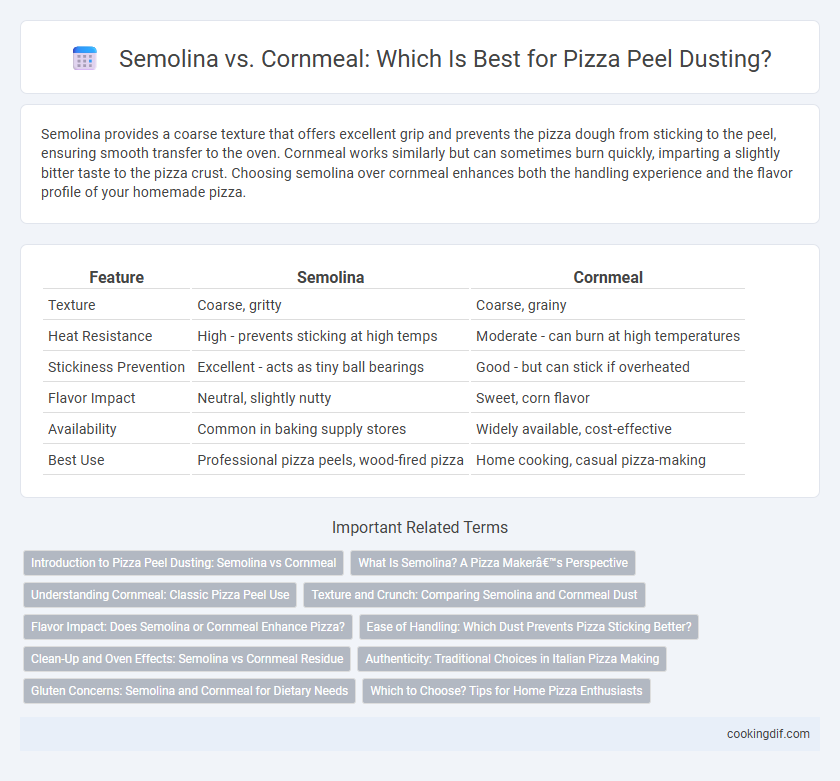Semolina provides a coarse texture that offers excellent grip and prevents the pizza dough from sticking to the peel, ensuring smooth transfer to the oven. Cornmeal works similarly but can sometimes burn quickly, imparting a slightly bitter taste to the pizza crust. Choosing semolina over cornmeal enhances both the handling experience and the flavor profile of your homemade pizza.
Table of Comparison
| Feature | Semolina | Cornmeal |
|---|---|---|
| Texture | Coarse, gritty | Coarse, grainy |
| Heat Resistance | High - prevents sticking at high temps | Moderate - can burn at high temperatures |
| Stickiness Prevention | Excellent - acts as tiny ball bearings | Good - but can stick if overheated |
| Flavor Impact | Neutral, slightly nutty | Sweet, corn flavor |
| Availability | Common in baking supply stores | Widely available, cost-effective |
| Best Use | Professional pizza peels, wood-fired pizza | Home cooking, casual pizza-making |
Introduction to Pizza Peel Dusting: Semolina vs Cornmeal
Pizza peel dusting is essential for preventing dough from sticking during transfer to the oven, with semolina and cornmeal being the two primary options. Semolina, a coarse durum wheat flour, offers a gritty texture that creates a dry barrier beneath the dough, enhancing slideability without burning quickly. Cornmeal, ground from dried corn, provides a slightly crunchier texture and resists sticking but tends to char faster, influencing crust flavor and appearance.
What Is Semolina? A Pizza Maker’s Perspective
Semolina is a coarse, yellow flour derived from durum wheat, prized by pizza makers for its ability to create a non-stick surface on pizza peels, preventing dough from sticking during transfer. Its gritty texture provides better grip compared to finely ground cornmeal, allowing for smoother sliding of the pizza into the oven. The high gluten content in semolina also contributes to a slightly crispier crust edge when any residue bakes onto the dough.
Understanding Cornmeal: Classic Pizza Peel Use
Cornmeal is a popular choice for dusting pizza peels because its coarse texture prevents dough from sticking while imparting a rustic crunch to the pizza crust. Unlike semolina, cornmeal does not absorb moisture quickly, helping to slide the pizza easily onto the stone or oven surface. Classic pizzerias often prefer cornmeal for its reliable performance and authentic texture that enhances the overall baking process.
Texture and Crunch: Comparing Semolina and Cornmeal Dust
Semolina provides a coarse, slightly gritty texture that helps create a distinctive crunch on the pizza crust without burning easily. Cornmeal, with its coarser granules, adds a more pronounced crunch but tends to brown and burn faster under high heat. Choosing between semolina and cornmeal for pizza peel dusting impacts the final crust texture, balancing crispness and browning to suit different baking preferences.
Flavor Impact: Does Semolina or Cornmeal Enhance Pizza?
Semolina adds a subtle nutty flavor and slight crunch to pizza crusts, enhancing texture without overpowering the toppings. Cornmeal offers a distinctly gritty texture and a mildly sweet corn taste that can enrich the overall flavor profile of the pizza base. Choosing between semolina and cornmeal influences both the taste and mouthfeel, making it essential to match the dusting agent with the desired pizza style.
Ease of Handling: Which Dust Prevents Pizza Sticking Better?
Semolina, with its coarse texture, provides superior ease of handling by preventing pizza dough from sticking to the peel, allowing for smooth transfer onto the oven surface. Cornmeal, while effective, tends to absorb moisture and can stick to dough more than semolina, complicating maneuverability. For optimal pizza peel dusting, semolina is preferred due to its excellent non-stick properties and consistent handling performance.
Clean-Up and Oven Effects: Semolina vs Cornmeal Residue
Semolina dusting on pizza peels tends to absorb moisture and can become sticky, making clean-up more challenging compared to cornmeal, which creates a coarser, less adhesive residue that is easier to sweep away. Cornmeal's granular texture also prevents dough from sticking to the peel and often produces a crispier crust as some grains toast in the oven. Semolina residue, when left in the oven, may burn faster due to its finer particles, potentially affecting oven cleanliness and flavor profiles.
Authenticity: Traditional Choices in Italian Pizza Making
Semolina is the traditional choice for dusting pizza peels in Italian pizza making due to its coarse texture, which prevents sticking while imparting subtle flavor without burning. Cornmeal, though effective, is less authentic and tends to char more easily, creating a bitter taste that diverges from classic Neapolitan pizza techniques. Authentic Italian pizzerias favor semolina as it supports the ideal delicate balance of crispness and chewiness in the crust.
Gluten Concerns: Semolina and Cornmeal for Dietary Needs
Semolina contains gluten, making it unsuitable for individuals with celiac disease or gluten sensitivity when used for pizza peel dusting. Cornmeal is naturally gluten-free, providing a safe alternative for those with gluten-related dietary restrictions. Choosing cornmeal ensures a non-stick surface without risking gluten exposure, catering to diverse gluten-free pizza preparation needs.
Which to Choose? Tips for Home Pizza Enthusiasts
Semolina offers a coarser texture that prevents dough from sticking to the pizza peel while adding a subtle crunch to the crust's edges, ideal for home pizza enthusiasts seeking a traditional Italian feel. Cornmeal provides a grittier surface that facilitates easy sliding of the pizza into the oven and imparts a slightly toasted flavor, making it a popular choice for those preferring a crispier base. Choosing between semolina and cornmeal depends on desired crust texture and flavor profile, with semolina favored for authenticity and cornmeal for a robust, crunchy bite.
Semolina vs Cornmeal for pizza peel dusting Infographic

 cookingdif.com
cookingdif.com